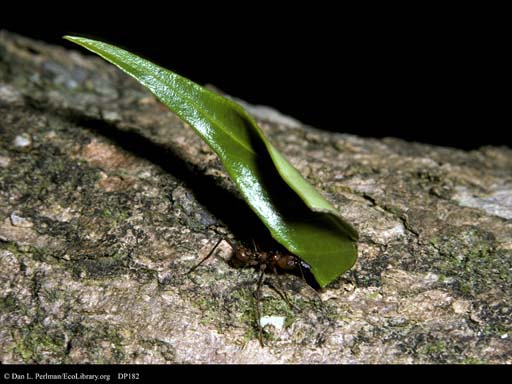Leaf cutter ant carrying leaf
| Title | Info |
|---|---|
| Common name | Ants, Leaf Cutter |
| Scientific name | Atta |
| Taxonomic group | Formicidae |
| Source | Dan L. Perlman |
| Ecosystems | Forests |
| Forests | Tropical rainforest |
| Ecological interactions | Mutualism; Herbivory |
| Mutualism | Ants and fungi |
| Behavior | Social |
| Organisms | Animals |
| Animals | Insects |
| Lessons | Mutualisms |

Leaf-cutter ant carrying large leaf fragment, Costa Rica. Ants are famous for their reputed strength, and this one is carrying a very large load.
Atta ants are the dominant herbivores in many parts of the New World Tropics, where large mammalian herbivores are relatively sparse. Leafcutter ants consume prodigious quantities of vegetation and some tropical ecologists estimate that Atta colonies may cut 12 - 17% of the total leaf production of a tropical rainforest. However, the ants do not themselves eat the leaves they cut; instead, they grow a special fungus on these leaf fragments.
This is a remarkably tight mutualism: leafcutter ant colonies cannot survive without their Leucocoprinus fungus and the fungus is found nowhere but in these colonies. Worker ants transport fragments of fresh leaves, flowers, and other vegetation back to the nest, where the plant material is chewed into ever-smaller pieces until it becomes a pulp. Tiny colony-minding workers then apply fecal droplets containing digestive enzymes to the mass, which becomes the substrate for the fungus gardens. The fungus essentially functions as a giant digestive system for these leafcutter ant colonies. Workers pluck nutrient-rich swellings known as gongylidia and feed them to the colony's larvae, while the workers themselves mostly feed directly on plant sap.
Atta colonies have the impressive ability to maintain fungal monocultures in their nest chambers. Workers keep fungal growths pure by constantly removing any introduced alien fungi and by frequently transferring their fungus onto fresh plant substrate. They also use an apparently mutualistic bacterium that protects the fungus garden against an especially virulent parasitic fungus in the genus Escovopsis. Thus the ants and fungi are actually part of a three-way mutualism with a filamentous bacterium that ensures the health of the fungus in Atta gardens.
Colonies can be huge, with some estimated to contain five million workers, and some of the galleries they excavate may be 20 feet (6 meters) underground. Moreover, the colony just has a single queen laying eggs; one leafcutter queen living in a lab lived more than 14 years. These ants and their trails of moving leaf fragments are among the most spectacular sights in the tropical rainforest.